Introduction
There are multinational companies who build representative offices outside the headquarters 120-150 years ago. There are family-owned companies in Europe who decided in a very early stage to be present in other European countries, besides the home country, but also overseas (EUA, South America, Australia and/or Asia). These companies had a very clear strategy established in early times and followed the same on regular basis.
Initially in the 50’s and 60’s South America was on the focus. At that time these companies have been seen as pioneers and the implementation of a local setup was normally linked to adventures. Much later the Asian market was on the pipeline of many companies. Looking for the future growth possibilities in the world, based on the population development, where certain markets will stagnate, other will shrink and few will growth, the African continent was on the agenda. Depending on the product portfolio companies always started to look much earlier on the major American market, too. Recently, with the population development in India, the subcontinent became again a focus for many global companies.
In the remote time the available communication tools with the subsidiary were the phone, telex, letters and later the fax. Many corporations were proud to have globally a sum of several successful “kingdoms” (independent subsidiaries). These managing directors of the subsidiaries had as a major target to build the local business by introducing the global available company products. Few even decided to have local products on the pipeline, specific for the local needs. The major issue was to build a local company with a proper structure to deliver results and consequently dividends to the headquarters. Not always, for different reasons, the global products were introduced in the local markets. This was not in line with what the headquarters wanted to see. Fact is that the global product managers were not always strict and strong. The managing directors, as “local owners”, decided which products should be available in the country. The scope of responsibility of a managing director at that time was immense and the job description of the post extremely wide.
One issue is the organizational structure related to the reporting line of the subsidiary and another is the defined role of the managing director in the subsidiary.
The organizational structure and the defined role of the managing director in a subsidiary will have many implications for the corporations. Depending on the organizational structure and the defined role of the managing director (job description), the company can achieve or fail the chosen strategy. Equally important seems to be the necessary and defined profile of the managing director of a subsidiary, mostly for the selection process.
This theme is totally actual across the globe, independently of the kind of business and the size of the company.
Initially, in the past, most of the multinational companies decided to have strong and totally independent managing directors in the countries to build up the businesses, markets, and company image. The idea was to have entrepreneurs capable to conquer markets and to build up a sustainable team.
Later, considering that not all companies were satisfied with the “independence” of the subsidiary and of the managing directors, and that several times the global products were not always available anywhere, and considering the new communication tools available (internet), multinational companies decided to centralize all decision making into the headquarters to assure uniformity of the implementations of these centralized decisions across the globus.
Part of the global companies decided that the subsidiary should focus mostly on the business (business first) by handing over the necessary “legal” role of the managing director (good governance) additionally to the head of the major business in the subsidiary. In this case the role of the “historic” managing director as an entrepreneur started to be not more necessary in the view of the headquarters. The post was handover accumulative to the head of the major business.
On the other hand, there have been companies which decided to have a “Dedicated Managing Director”, who would not be responsible for the business, but only for the good governance of the subsidiary. Clear is that the new models are based on a matrix organization where the managing director and the heads of business units would have two superiors, one the functional and another the legal.
Several managing directors started to be demotivated by seeing the new role of the managing directors, as a “facility manager”, because the major role defined for the managing director was only to assure the good governance. Several previously defined as important attributes or profile and roles of the managing directors started to be neglected and to be considered as less important. This means that there has been a change in the necessary profile of a managing director. One point is the corporate good governance, and the other issue is the opportunity existing in the hand of the managing director of a subsidiary to build and growth the local company, businesses, brand, communication, image, and global products.
The changes were accompanied with new job descriptions for the managing directors. New job descriptions started to be defined also for the heads of the major business, to assure a successful implementation of the new setup.
The different modalities to deal with the subsidiary and with the role of the managing director can have an impact on a subsidiary. This is the aim of the paper, to find out how companies should select a managing director for a subsidiary (international assignment), independently of the structure or defined role.
Not neglected should be the different cultures and legal setups in different regions which should be considered when a selection is in place. There are many cultural and historical issues impregnated in companies and in the local subsidiaries. These factors can affect drastically the communication and will influence the businesses and the performance of the company or engagement of the employees.
Considering the different possible organizational structures, roles of the managing director for the subsidiary it is even more important to select the proper position holder for each setup.
The question is, if global companies do have a proper selection system and if all necessary parameters for the selection are used. Most of the companies do have an own way to select a manging director for an international assignment. The question is if it is working. This is the major aim of this paper.
There are different titles equivalent to managing director depending on the country, region, or organization[i]. Sometimes the title is a legal requirement or linked to the local traditions and culture. There are specific cultural and traditional issues in the Asian countries. In the case of South Korea, the title in English is less important than the Korean Honorific Title. The Korean language and culture have a system of honorifics titles that recognizes and reflects the hierarchical social status of people in the society. This is considered important in that culture for the audience to be addressed. People use honorifics titles to show their social relationship regarding their age, social status, gender, or grade of intimacy. The honorific titles system is reflected in honorific particles, verbs with special honorific forms or honorific markers. This system has a huge implication in the relationship between people in the society, but specially in the organizations. In the business world and in the company this system will dictate how people interact in a company with superiors, peers, and subordinates and consequently has an implication in the communication, behaviour, and trust. The titles will interfere in the open communication and relationship in an organization. The titles will be also an indicator of the status in the community.
Where should the candidate come from? Internal or external? From the country or from somewhere else? What are the pros and cons in each of the cases for the specific company? This needs to be agreed in advance by the direct superior together with human resources.
Who should interview the candidate? How many opinions are required? How the interview should be done? How to observe the candidate and relatives? Who should decide about the best candidate? How many opinions are required (direct superior, human resources, heads of major business units)? There are always reasons for one or another model. Fact is that the company should have clear and transparent rules & regulations implemented about all the questions above.
On the end, human resources should consolidate all the information and the direct superior should take the final decision. The superior will be measured in the performance appraisal if the right candidates have been chosen and the targets achieved. For this reason, the direct superior should take the final decision about the candidate to be posted as managing director.
When and who should approach the candidate? What about the first visit to the country (see and look)? What should be seen during the visit (housing, schools, recreation, culture, etc.). Organization and reports are necessary and need to be defined in advance. Who should prepare the visit and when the visit should be done? Is there a rule? Who should do it? When and who should approach the candidate? The reports are important for the decision making.
A training program is fundamental from a cultural aspect till business’ issues, good governance and take over plan. Normally companies should have an internal induction program for new managing directors to assure that topics like compliance, environment, health are not neglected. This is what everyone believes. In the research, something different was found out: only a little over than 35% of the managing directors got a specific training.
Who and how the family should be prepared? What is important for the family? Who will assist the family? Is an induction necessary and required for the family? How should it be done? The family member should get the same cultural training as the candidate and normally the partner of the predecessor will induct in the new country the family (mainly the partner).
A follow up of the progress (candidate and family) is fundamental. Who will be involved? Normally the direct new superior will accompany closely during the first months the new managing director by calls or sporadic visits. On that opportunity the superior will have the chance to meet the partner of the managing director and can find out how the relatives are adapted in the new environment. This is important, because only if the relatives are well settled down, the managing director will be able to perform well.
To finalize it is important to mention that company’s Vision, Mission, and Values will be a strong help to a managing director to perform accordantly. The topics Compliance, Risk Management, Safety, Health & Environment are equally important than financial figures. It is not only important to see the achievements of a subsidiary, but also how the targets have been achieved and what is the engagement and satisfaction level of the staff in the local organization. This is normally visible with an employee survey, which most of the conglomerated are doing once a year or every second year.
Methodology and Research Methods
Besides the consideration of the mentioned articles in the bibliography published, a survey by interviews with managing directors, superiors & human research managers of multinational companies and with employees (direct subordinates of managing directors) of the same entities were carried out. Additionally, external consultants dealing with managing directors participated in the survey. Information from the discussions were considered in this article. Not all detailed and specific instruments, ideas and examples from interviews could be considered because sometimes they were too related to the company’s internal issues. The survey was done through SurveyMonkey and got over 100 participants from different kind of businesses and regions.
Over 80% of the participants of the survey belong to European based headquarters.
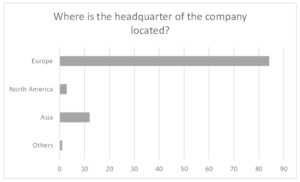
Most of the companies do have over 10 thousand employees worldwide.
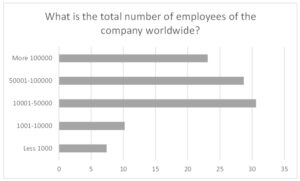
Nearly 55% of the participant companies have a divisional and 35% a matrix organizational structure.
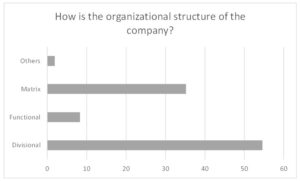
60% of the managing directors report to the level 2 or 3 in the organization and only a little more than 25% to a board member in the headquarters.
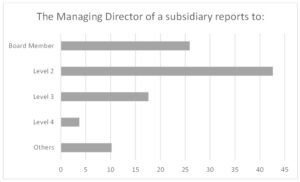
Over 90% of the managing directors in the survey are males. The same happened with the superiors or advisors. Only the number of females subordinates of managing directors increased to over 30%.
Strategy
When the topic of how the selection of a managing director should be done is raised, one of the basics is that a strategy for the specific country for which a managing director should be selected must be in place. The global organization should have a clear strategy for that subsidiary based on what should be achieved. This strategy must be on short, medium, and longtime defined. This means that on base of the strategy an organizational structure, clear reporting line of the managing director, job description and later a profile of the managing director should be implemented and in place. This is fundamental because different organizational structures, duties and specific profiles will be necessary for each case or setup.
When a global, regional, or local organization start with the strategic management, the leaders should have as a base for the formulation the Vision and Mission of the organization. For this, the leaders should ask themselves what the organization want to become (Vision) and what the business is (Mission). Equally important is to have the Values which the company want to follow, and which will dictate the way to work.
In the past the major “vision” of a company was to create profit from the business. The changes in the market and society also changes the perspective of the “vision”. Nowadays, companies will see much more as a vision the social values created by the organization Vision and mission are different points and will be related to different periods. Normally vision will not have a timeframe and will be related to an open end. Mission is more related to the social aims of the organization.
Fact is that both are a kind of prerequisite to start with the strategic formulation in the company.
The values will dictate how the operations of the company should be run. This is extremely important not only for the formulation, implementation, and control of a strategy, but also for the daily way to operate the business internally and externally. One more prerequisite for the managing director to be selected.
Companies realized that by publication of the vision, mission, and values on the homepage of the organization will assure that all stakeholders will know what the company is and what the company want to be and how the company manage the operations.
There is a new trend in the recent years whenever organization prepare a strategy. Ethics, social responsibility, and sustainability are concepts followed by the major of the organizations. Considering that the market and the society changed and started to look for these issues, the company also included this new trend in the strategic process and formulation. In this case, these topics need to be included in the selection process of a candidate.
All the points above will dictate the strategic direction of the organization and will on the end be embedded in the strategy of the company. Consequently, all these points will be relevant for the selection of the managing director.
Another important point to be mentioned is the crisis. There are statistically not five years without any kind of crisis for a company. Even knowing this fact, the strategic process is important because can identified and prepare the organization to act, react, prevent or to overcome the difficult period. Normally companies do have crisis management systems where specific and relevant processes, products, partners etc. are described with immediate alternatives in case of a crisis. The same process can be included in the strategic process, this means that for relevant changes in the market etc. Plan Bs are preprepared.
All this need to be considered when a manging director should be selected for a specific country and for a specific period.
Organizational Structure
There are, as previously mentioned, several possible organizational structures for a subsidiary. Starting from a classical organizational structure, where a managing director will be responsible for all activities in the country, like all kind of businesses, all functions etc. In this classical approach the head of the local organization will be responsible for all facts and figures of the subsidiary and will be the legal responsible for the total entity. Another possibility is where the managing director will be responsible only for the good governance of the subsidiary and all the businesses and functions will have a functional superior in the headquarters or in the region. This model is called also as dedicated managing director. The last case is where the managing director will also be responsible for one business unit. In this case he will have a functional superior in the headquarters or region who will measure his achievements as managing director and as head of one business unit. All other heads of the other business units and all the heads of functions (finance, logistics, production, human resources etc.) will equally have a functional superior in the headquarters or region.
These are the most possible setups implemented currently in global organizations.
As previously mentioned, in the survey, most of the companies have the matrix or divisional organizational structure implemented.
In the survey was found out that the size of the market, if the country is a strategic country and the complexity of the business are the 3 major reasons for a decision about an organizational structure for a subsidiary. This topic is important when a selection process of a position of managing director for a specific country will start.

Job Description
The basic is that the organizations should have implemented clear and transparent job descriptions, targets for the subsidiary and for the managing director and finally all linked to the country company strategy.
The basic functions of management are planning, organizing, leading, and controlling. These functions are related to all managers and not only to managing directors. In the job description, the job purpose, key accountability, service delivery, business development, people management, SHE (safety, health, environment), risk management, quality (company rules & norms), compliance, finance authority, self-development required, dimension of the job (direct reports, internal and external contacts), planning, problem solving expected, technical effectiveness, acquired experience and qualifications and eventually other requirements should be mentioned. This will assure that for a decision of a candidate all requirements will be considered.
For each of the setups mentioned under the organizational structure, a proper job description will need to be elaborated. This is fundamental, mostly considering that a performance appraisal will need to be done with the superior of the managing director.
Depending on the organizational structure and reporting line, the job description will change and will have different focus and expectations.
Considering laws in the host country, the job description will need to be adapted. Sometimes, the managing director (when dedicated managing director) will not be responsible, as decided by the global organization, for the businesses, but under the local law and regulation the head of the subsidiary will be seen by the host government as the total responsible for all activities. This can create a conflict between what a company want to implement or what the company want to see and what and how the local government will act. For the targets agreement between the managing director and his direct superior this will be extremely important to be clarified. Equally, this will be important for the selection of a candidate.
The three more relevant skills of a managing director, as results of the survey, are leadership, strategic thinking, and communication. This confirm that the managing director should lead the strategic process in the local company, assure that a local strategy is developed, implemented, followed, and controlled. The managing director should also take care of the proper communication of the strategy.
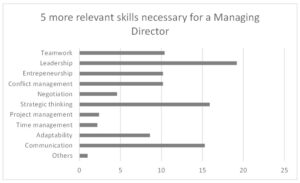
Profile
There are two groups of necessary skills for a managing director. The first is related to the technical skills, leadership, emotional intelligence, and capability to resolve complex problems. The second is related to adaptability & flexibility, family issues, hobbies, experience, development plan and languages.
Normally, as answered by managing directors in the survey, leadership, strategic thinking, and communication are the most relevant and necessary skills of a managing director, followed by entrepreneurship, teamwork, conflict management and adaptability. For the companies, the most relevant skills are leadership, strategic thinking, and teamwork. The topic communication, adaptability, entrepreneurship, and conflict management are seen as less relevant by the organizations.
Depending on the country, the language, local traditions, dress code, body language, seniority, local politics, and religion can require a specific profile of a managing director. Depending on the adaptability of the managing director and of the family, certain regions can bring problems to the candidate, family and consequently to the subsidiary. The clime zones are relevant in the selection of the managing director because not always the candidate and relatives will adapt in a totally different clime.
All the countries worldwide are in different steps of development and not everything will be as in the home country. Even not the security. For this reason, this topic should be also considered.
These are the reasons, by experience, why managing directors see adaptability as an important skill for this position.
The company should have a clear necessary profile for the job holder of the position of a manging director of a subsidiary company.
When a job description should mention the specific duties to be perform and the related responsibilities for the role of managing director of a subsidiary, the job profile should mention the personal necessary qualification and skills which are important and relevant for a manging director to successfully perform the related job.
Most of the companies do have a clear job description, but rarely a clear profile for the job holder.
Often, unfortunately, companies mix both topics. Only during the post survey interviews with managing directors and superiors this came clearly out.
Whenever human resources start to look for a selection of a candidate of the position of managing director, the job profile should be the base of the process. The profile will have fundamental information about the role psycho-aptitude features, technical and professional requirements, and personal elements. Besides the activities and the responsibilities of the job holder, the profile should include the necessary experience and skills and finally the level in the global organizational structure (scope of responsibility). In the profile can be mentioned also which skills are fundamental and which one will be appreciated from the candidate.
Only with all this information, the recruiter will be able to select a pool of candidates.
Targets / Grading / Development
It is fundamental that the targets should be clear, measurable and with a time frame regarding when the targets should be achieved. Only on this way the performance can be defined and measured with transparency. There are companies with quarterly, half-year or yearly reviews.
Besides the topics above mentioned, one additional very important issue is the grading implemented in the companies. Grading is the level which each job in the organization is defined in relation to other jobs. The major issues are the scope of responsibility and the complexity of the job. There can be managing directors with totally different grades, because of totally different scopes of responsibility (sometimes in one case are more businesses units than in other countries or number of products, or even number of employees) and the complexity of the job (size of businesses, business model, complexity of the operation, local culture or regarding the stability of the economy in the country).
Normally, during the performance appraisal, the superior will discuss with the subordinate (managing director) the development plan for the next years and the carrier plan. Important is that both should agree, otherwise the topic needs to be escalated together with human resources to the next higher level.
Selection
The major discussion will be who should select the candidate: human resources or the superior? Or both? An additional question will be whether the company has an assessment centre implemented. This assessment could be an internal or an external.
Fact is that with the profile and with the job description, human resources can provide a list from the central candidates’ data. This list should be complemented with eventual candidates which the superior would like to see considered. Important is that both parties should agree on a list based on profile and job description.
The next step will be who, how, and when to approach the candidate. Leading with human beans means that always expectation can raise, and eventual demotivation can be appeared. This should be avoided. For this reason, a strategic plan regarding the selection process needs to be elaborated in advance. Not forgotten should be the topic of information to the current superior of the candidate.
A short time frame is always important and is normally not respected by the companies creating unnecessary delusions and false expectations, even frustration.
With the final selection, a training plan needs to be communicated to the selected candidate. A communication plan for the organization and for the subsidiary needs to be prepared to avoid rumours and instabilities.
Training
What kind of training will be necessary for the managing director? Depending on the organizational structure, the role or job description and the profile, a specific training should be provided. There are cases where businesses and product related trainings will be necessary, or, in other cases, a good governance training is fundamental. Depending on the targets, even a specific communication training (how to deal with the press) can be part of the necessary package.
Another important point is the hand over. Will the new appointed managing director work together with the previous managing director for a certain time frame? All these need to be pre-defined and a proper plan elaborated.
Only nearly 50% of the managing directors interviewed are sent to an assessment centre prior to the indication for this post.
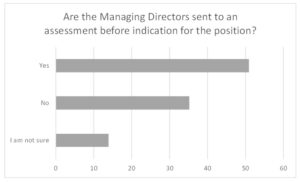
Over 55% of the managing directors are not getting a specific training prior to the takeover of the job.
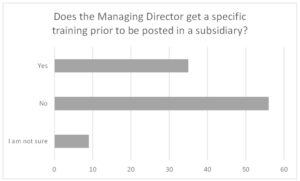
Nearly 90% of the companies have a performance appraisal system implemented for the managing director of a subsidiary.
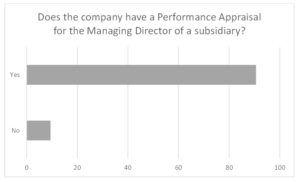
Even with a relative high number of managing directors working in a matrix organization, only few have a performance evaluation with two superiors. This is not in line with a matrix organization and system. Normally, in a matrix organization, where a managing director will have two superiors, the feedback of both needs to be considered.
A topic, not deeply analysed in the survey, was the succession plan. In the interviews, it came out that most of the companies have a weak succession plan in place. Only few companies include in the selection process of a managing director possible candidates as future successor of the post.
Conclusions & Recommendations
There are different organization models for subsidiaries of multinational companies. Most companies do have divisional organizational structures or matrixes.
There are companies where the reporting lines of the managing director will be linked to a regional or global head of a unit and there are structures where the local managing director will report to board members at the headquarters. It doesn’t matter what kind of structure is in place, the support and involvement of the managing director in the strategic management can always be implemented and will be paid back easily.
Fact is that, even if the managing director is not responsible functionally for the businesses, at least he will be legally responsible for the local company. This means that he should and needs to be deeply involved with the strategic management and get on regular basis all the necessary information about the businesses, otherwise he can be sometimes even in legal problems.
As a result of the research, the performance of a subsidiary is linked to the scope of responsibility of a managing director. This is based as results of the survey. Nevertheless, to finalize, the scope of responsibility doesn’t need to be always prefixed by the global organization – it can be taken by the managing director. This means that a managing director will need to be diplomatic, flexible, creative and a pure informal leader. These topics are normally not listed in the profile of the job. Fact is that in this way he will see the success of the organization and the good results in the employee surveys.
The basic is that the organizations should have implemented clear and transparent job descriptions, targets for the subsidiary and for the managing director and finally all linked to the country company strategy.
It is fundamental that the targets should be clear, measurable and with a time frame regarding when the targets should be achieved. Only in this way the performance can be defined and measured with transparency. There are companies with quarterly, half-year, or yearly reviews.
Another finding is that companies should implement a way to get the feedback for the performance appraisal from both superiors. Even if only one can finalize the appraisal papers (normally the global business unit head), it is important to get the feedback from the legal and second superior in the system.
There are two groups of necessary skills for a managing director. The first is related to the technical skills, leadership, emotional intelligence, and capability to resolve complex problems. The second is related to adaptability & flexibility, family issues, hobbies, experience, development plan and languages. Part of the technical skills is the capability to implement the local strategy, but the second is in most of the cases forgotten or overseen.
In the survey, leadership, strategic thinking, and communication have been appointed as the most relevant skills of a managing director. Fact is that in most of the cases only the business figures are the most important topics seen by the superiors. The way how the achievement was done is neglected.
Another important point overseen by the selection process is the capability of the partner of the managing director to deliver the necessary support. Often the partner will need to accompany the managing director to events, receptions or will need to host. Not everyone is suitable and capable to perform properly.
A training program is fundamental from a cultural aspect till business issues, good governance and take over plan. Normally, companies should have an internal induction program for new managing directors to assure that topics like compliance, environment, and health are not neglected. This is what everyone believes. In the research, something different was found out: only a little over than 35% of the managing directors got a specific training. The recommendation is that companies should include in the induction program for a new managing director the training in the global strategic unit to assure that the global strategic thinking of the organization will be present in the subsidiary.
In summary, there are few important issues unnoticed by global organizations:
- Assessment centre prior to the indication is recommended;
- Targets agreement and performance appraisal need to be done with both superiors in the case of a matrix organization;
- Training prior to the takeover is necessary (business issues and good governance);
- Feedback from the managing directors about the necessary skills for this position (depending on the country), can be different;
- Job responsibilities under the law of the host country;
- Evaluation of the partner prior to the decision.
Only an assessment centre will provide a 360-degree approach of the candidate and will be totally impartial. In this way, eventual preference of human resources or of the future superior of the candidate can be eliminated.
All the performance system needs to be transparent and clear before a selection is done. These papers will need to be discussed with the candidates during the selection process.
Under necessary training, is not only a cultural, but also a training related to the business and good governance meaned.
Prior to the preparation of a profile, discussions with current managing directors with the proposal to get inputs is recommended. This is rarely done by organizations, as the survey demonstrated.
Independently of the organizational structure and job description prepared by the organization, the local law & order regarding the responsibility of the legal head of the entity should be included in the job description. In the survey with dedicated managing directors, it came out that by the companies the managing director will not be responsible for the businesses but by the local law; this will be seen differently by governments.
To finalize, it is important to mention that a company’s vision, mission, and values will be a strong help to a managing director to perform accordantly. The topics strategy, compliance, risk management, safety, health & environment are as equally important as financial figures. It is not only important to see the achievements of a subsidiary, but also how the targets and the strategy have been achieved and what is the engagement and satisfaction level of the staff in the local organization. This is normally visible with an employee survey, which most of the conglomerated are doing once a year or every second year. In the survey done, it is clear that about 90% of the companies do have employee surveys.
As a conclusion, it should be mentioned that during the interviews realized after getting the results of the survey, most of the managing directors mentioned that there are three important elements which a managing director will need to perform properly: diplomacy, creativity, and flexibility. Diplomacy was mentioned regarding how to deal internally with pears even if the topic is not officially on the responsibility of the managing director. The flexibility was mentioned considering that fast and proper unforeseen agreements and decisions often are required. Finally, creativity was mentioned regarding how to deal properly with all the issues.
Notes
- (Srivastav, 2019)
- (Korean company hierarchy, structure and business titles, n.d.)
- ((PDF) Open Communication: The Base for a Successful Company, n.d.)
- (Bucăţa & Rizescu, 2017)
- ((PDF) Korean Titles: How to Go Away from Them, n.d.)
- (Mirvis et al., 2010)
- (Br, n.d.)
- (Groh, 2014)
- (9 Types of Organizational Structure Every Company Should Consider, n.d.)
- (The Autonomy of Foreign Subsidiaries. An Analysis of Headquartersubsidiary Relations: Norsk Geografisk Tidsskrift – Norwegian Journal of Geography: Vol 57, No 1, n.d.)
- (Yumpu.com, n.d.)
- ((PDF) An Evaluation of a Managing Director’s Performance in an Organization in Terms of Time, n.d.)
- (View of THE ROLE OF LEADERSHIP IN STRATEGIC MANAGEMENT, n.d.)
- (Job Profile vs. Job Description, n.d.)
- (What to Expect from a Management Assessment? | 123test, n.d.)
- (Developing Managing Directors | Emerald Insight, n.d.)
Bibliography
- 7 types of reporting structure you might encounter at work. (n.d.). Indeed Career Guide. Retrieved April 12, 2023, from https://uk.indeed.com/career-advice/career-development/reporting-structure
- Br, C. (n.d.). VISION, MISSION AND CORPORATE VALUES. A COMPARATIVE ANALYSIS OF THE TOP 50 U.S. COMPANIES. 21.
- Bucăţa, G., & Rizescu, A. M. (2017). The Role of Communication in Enhancing Work Effectiveness of an Organization. Land Forces Academy Review, 22(1), 49–57. https://doi.org/10.1515/raft-2017-0008
- Developing managing directors | Emerald Insight. (n.d.). Retrieved April 9, 2022, from https://www.emerald.com/insight/content/doi/10.1108/09622519510771861/full/html
- Job Profile vs. Job Description: What’s the Difference? (n.d.). Indeed Career Guide. Retrieved April 12, 2023, from https://www.indeed.com/career-advice/finding-a-job/job-profile-vs-job-description
- Korean company hierarchy, structure and business titles. (n.d.). Retrieved January 11, 2021, from https://www.linkedin.com/pulse/korean-company-hierarchy-structure-business-titles-michael-kocken
- (PDF) An Evaluation of a Managing Director’s Performance in an Organization in Terms of Time. (n.d.). Retrieved April 9, 2022, from https://www.researchgate.net/publication/262723973_An_Evaluation_of_a_Managing_Director’s_Performance_in_an_Organization_in_Terms_of_Time
- (PDF) Korean Titles: How to go away from them. (n.d.). Retrieved March 9, 2023, from https://www.researchgate.net/publication/357279714_Korean_Titles_How_to_go_away_from_them
- (PDF) Open Communication: The Base for a Successful Company. (n.d.). Retrieved March 9, 2023, from https://www.researchgate.net/publication/353430453_Open_Communication_The_Base_for_a_Successful_Company
- Srivastav, A. K. (2019, September 8). CEO vs Managing Director. WallStreetMojo. https://www.wallstreetmojo.com/ceo-vs-managing-director/
- The autonomy of foreign subsidiaries. An analysis of headquartersubsidiary relations: Norsk Geografisk Tidsskrift—Norwegian Journal of Geography: Vol 57, No 1. (n.d.). Retrieved April 11, 2022, from https://www.tandfonline.com/doi/abs/10.1080/00291950310000794?journalCode=sgeo20
- View of THE ROLE OF LEADERSHIP IN STRATEGIC MANAGEMENT. (n.d.). Retrieved December 13, 2021, from https://www.granthaalayahpublication.org/journals/index.php/granthaalayah/article/view/IJRG17_A05_279/1726
- What to Expect from a Management Assessment? | 123test. (n.d.). Retrieved April 9, 2022, from https://www.123test.com/management-assessment/
- com. (n.d.). Job Description Job Title: Managing Director Reporting Line … Yumpu.Com. Retrieved April 12, 2023, from https://www.yumpu.com/en/document/view/37055518/job-description-job-title-managing-director-reporting-line-











